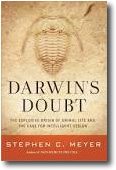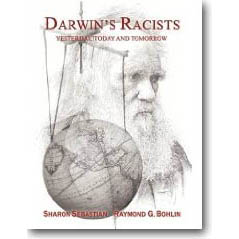Dr. Ray Bohlin reviews Stephen Meyer’s book Darwin’s Doubt, showing that the sudden appearance of complex animal forms in the Cambrian cannot be explained by evolutionary mechanisms.
The Essence of the Cambrian Explosion 
The fossil record of the Cambrian Period has been known as a problem for evolutionary theory since Darwin’s Origin of Species in 1859. Darwin was aware of the sudden appearance of complex animal forms in the Cambrian from his own collecting in northeastern Wales. Complex animal forms such as trilobites seemed to appear with geological suddenness with no apparent ancestors in older rocks below them.
 In his 2013 book, Darwin’s Doubt: The Explosive Origin of Animal Life and the Case for Intelligent Design{1}, Stephen Meyer quotes Darwin from the Origin of Species: “To the question of why we do not find rich fossiliferous [fossil-bearing] deposits belonging to these assumed earliest periods prior to the Cambrian system, I can give no satisfactory answer. . . . The case at present must remain inexplicable; and may truly be urged as a valid argument against the views here entertained.”{2}
In his 2013 book, Darwin’s Doubt: The Explosive Origin of Animal Life and the Case for Intelligent Design{1}, Stephen Meyer quotes Darwin from the Origin of Species: “To the question of why we do not find rich fossiliferous [fossil-bearing] deposits belonging to these assumed earliest periods prior to the Cambrian system, I can give no satisfactory answer. . . . The case at present must remain inexplicable; and may truly be urged as a valid argument against the views here entertained.”{2}
Meyer provides some of the historical context of this period and Darwin’s disagreement with the eminent paleontologist of his day, Louis Agassiz of Harvard. Darwin’s solution to his dilemma was to suggest that the fossil record is incomplete and that he fully expected that abundant fossils would be found to indicate the evolutionary origin of these Cambrian animals. However, in the intervening century and a half, the problem has not been resolved. If anything, as we have gained more knowledge of animal life and development and found numerous deposits of periods just prior to the Cambrian, the problem is worse than Darwin perceived.
Early in the 20th century, a rich Cambrian deposit was found in the Canadian Rockies, the Burgess Shale. Entirely new organisms were found exquisitely preserved, many with soft-body parts well preserved. Then in the mid-1980s, an even earlier Cambrian deposit was found in Chengjiang, China. This deposit revealed an even richer diversity of organisms than the Burgess Shale, and even finer soft-body preservation—even down to eyes, intestines, sensory organs and stomach contents.
Later work in different parts of the world had timed the Cambrian explosion to a roughly 5-10 million year time frame around 530 million years ago [with the Cambrian period itself beginning 543 million years ago] in the evolutionary time frame. Though that’s a very long time, even for evolution, it’s practically instantaneous when discussing the origin of entirely new body plans. As Meyer faithfully recounts, Darwin’s dream of an ever-increasing rise in complexity and diversity is shattered by the geologically abrupt appearance of both complexity and diversity.
What has been referred to as “Darwin’s doubt” could be more aptly referred to as “Darwin’s headache.” In this article I will explore some of the additional problems this sudden explosion of animal body plans poses for evolution. While committed evolutionary materialists pretend to not be disturbed by these developments, those with open minds are questioning this long-held theory and giving new consideration to Intelligent Design.
Evolutionary Explanations of the Cambrian Explosion
Even Darwin recognized the Cambrian as a puzzle for his theory. Darwin hoped that further exploration of fossil-bearing strata would reveal the ancestors of the Cambrian animals.
In the early 20th century, Harvard paleontologist, Charles Walcott, found a new Cambrian deposit in the Canadian Rockies, the Burgess Shale. The Burgess Shale contained new creatures never seen before and was able to preserve some soft-body parts, also never seen before. This proposed an even greater problem than Darwin knew. Older deposits were still not revealing the ancestors of the Cambrian, but now there was even more diversity and novelty than anyone had imagined. The discovery of a predator, the up-to-meter-long Anomalocaris, demonstrated there was a well-defined ecosystem with plant producers, plant consumers and carnivores.
The origin of the Cambrian fauna seemed to turn Darwin’s theory on its head. Darwin expected all animal life forms to be descended from a single common ancestor through a lengthy process of descent with ever-so-slight modification. But these Cambrian novelties appeared quite suddenly with no ancestors. That is not evolution as Darwin envisioned it. Walcott suggested two reasons for the disparity. First, he suggested that the immediate Pre-Cambrian deposits containing the Cambrian ancestors were to be found on the ocean floor. Subsequent off-shore drilling for oil provided a unique opportunity to test this hypothesis. But most of the sea floor is much younger than the Cambrian. If there were Pre-Cambrian deposits, they no longer exist.
Walcott also tended to be a “lumper” in taxonomic terms. That means he fit fossils into already existing categories whether they fit well or not. This appeared to minimize the explosive part of the Cambrian. But additional field excavations in the Burgess Shale, as well as in different parts of the world, revealed that many of these Cambrian creatures were unique and that their descendants are not known today—they are extinct. The novelty of Cambrian forms is more pronounced than ever.
The late Stephen J. Gould of Harvard famously described the uniqueness of these Cambrian creatures when he said; “Imagine an organism built of a hundred basic features, with twenty possible forms per feature. The grab bag contains a hundred compartments, with twenty different tokens in each. To make a new Burgess creature, the Great Token-Stringer takes one token at random from each compartment and strings them together. Voila, the creature works—and you have nearly as many successful experiments as a musical scale can build catchy tunes.”{3}
Fossils have been found in sediments older or below the Cambrian but these fossils do not appear to be ancestors of the Cambrian creatures. They were also quite unique and most are now extinct. The mystery remains.
Libraries of New Genetic Information Needed: Pronto!
All Darwin had to examine were the unique animals found in Cambrian deposits. He knew nothing of genetics and the need for new genetic information.
Paleontologist James Valentine has gone so far as to say that probably all the living animal phyla had their beginning in the Cambrian period, over 500 million years ago. We do find multi-celled animal fossils 20-30 million years before the Cambrian, but only sponges seem to resemble anything we find in these deposits.
A phylum is an upper level of classification. For instance, all vertebrates are in the same phylum. Insects, crustaceans, and spiders are also in the same phylum. The phylum represents organisms with a distinct body plan though there may be many variations on that theme. In order to have all these new body plans or phyla appear in the Cambrian in a geological instant, you need a lot of new genes or genetic information. Different types of cells are needed. New genes are needed to grow new body plans out of a single-celled fertilized egg. With different cell types come different kinds of functions and cell types each needing specific gene products to give them their unique functions.
When protein sequence and gene sequence comparisons were begun in the late 70s, there was an expectation that comparing gene sequences would solve relational puzzles among living organisms but that by comparing genes from different phyla, it could be determined how phyla were related. The Cambrian fossils offer no such clues since most animal phyla appear at nearly the same time. But several decades of gene sequence comparison studies have revealed no consistent evolutionary scheme. As Meyer summarizes, “Many other studies have thrown their own widely varying numbers into the ring, placing the common ancestor of animals anywhere between 100 million years and 1.5 billion years before the Cambrian explosion.”{4}
Meyer does a great job of articulating why there would need to be an information explosion along with the Cambrian explosion. Accounting for all this new information, in a relatively short period of time, by known processes is a herculean task. If evolution solely depends on a Darwinian model, then mutation and natural selection must be able to account for the explosive rise of new genes and regulatory gene networks during the Cambrian. Meyer spends several chapters working this through. Achieving the extreme specificity of proteins through the slow, plodding, processes of mutation and natural selection appears impossible.
In the next section I address an even greater difficulty of the Cambrian explosion. Darwinism has always needed a slow gradual accumulation of genetic change. However, with the relatively quick appearance of very different forms of animals in the Cambrian, is Darwinism up to the task?
The Exasperating Problem of New Body Plans
Darwin understood nothing about how animal body plans are laid out and built in the early embryo.
Since Darwin’s time we have learned a great deal. And none of what we have learned offers any help in deciphering how all these new body plans originated in such a short geological time period in the early Cambrian. The overall structure and shape of an organism is laid out early in embryonic development. Particular genes necessary for development are tightly controlled in when and how they are expressed. These genetic regulatory programs operate only in early development and they limit the possibilities of the final form of the organism.
Biologists use a classification term, phylum, to refer to the largest category of animals and plants. Humans belong to the Phylum Chordata, which includes all the vertebrates. Insects are in the Phylum Arthropoda, which includes crustaceans and spiders. These two phyla possess very different body plans, and the genetic programs to build these plans are very different in the earliest stages, even in the first few divisions of the fertilized egg. The Cambrian demonstrates that these very different body plans arise in less than ten million years of time geologically. Is that possible? All Darwinism has to work with as the source of genetic variation, are mutations.
In 1977, French evolutionist Pierre Paul Grassé noted that mutations don’t provide any real evolutionary change. Mutations only seem to provide only a slightly different variety of what already existed.{5} Twenty years later, a trio of developmental biologists noted that modern evolutionary theory explained well how the already fit survive and reproduce. But just how organisms came to be that way, the modern theory seemed silent.{6} Evolutionary biologist Wallace Arthur explained that modern textbooks told the same stories about how finch beaks and the color of moths changed to suit their environment, but nowhere was it discussed how the organism as a whole came to be so integrally functional.{7}
These problems have been further addressed in recent years but nothing seems to propose any clear answers as to how new body plans could have appeared in such a short span of evolutionary time.
Steve Meyer summarizes his review of these difficulties in the light of the Cambrian saying, “The Cambrian explosion itself illustrates a profound engineering problem the fossil data does not address—the problem of building a new form of animal life by gradually transforming one tightly integrated system of genetic components and their products into another.”{8}
An Opportunity for Intelligent Design
I have documented how the sudden appearance of new forms in the Cambrian creates mysteries in terms of the fossils, genetics and developmental biology.
In chapter 18, Meyer turns his attention from the observation that modern evolutionary theories do not explain the sudden appearance of all the major animal groups in a short burst of geologic time, to what can explain the Cambrian Explosion. He carefully argues that Intelligent Design has all the causal power to bring about what is needed in the Cambrian.
Initially he summarizes the conclusions of two important evolutionary students of the Cambrian, Douglas Erwin and Eric Davidson. Together these scientists have listed a few of the observations any evolutionary cause must explain. First, whatever the cause of the Cambrian Explosion, it must be able to generate what is referred to as a top-down pattern. That is, the broad general categories of animals appear before there is any refinement in these characters. Second, the cause must be capable of generating new biological forms relatively rapidly. Third, this cause must be capable of constructing, not just modifying, complex genetic regulatory circuits.
They also note, as Meyer reports, that no existing theory of evolutionary change can accomplish any of these necessary events.{9} Davidson and Erwin are quite insistent that the processes operating in the early Cambrian were fundamentally different from anything operating in nature today. That’s a tall order. But Meyer adds a few more prerequisites for a cause for the Cambrian Explosion. In addition to the need for rapid development of a top-down pattern, new body forms and creation of new genetic regulatory circuits, Meyer observes that this cause also needs to generate new digital information in the DNA and new structural information that cells use routinely. There also needs
to be the development of new types of information that are precisely coordinated to specify brand new body plans.{10}
A designing intelligence may be the only sufficient cause that can accomplish all of these events within any time frame, let alone the 5-10 million years of the Cambrian Explosion. Meyer concludes the chapter by writing, “The features of the Cambrian event point decisively in another direction—not to some as-yet-undiscovered materialistic process that merely mimics the powers of a designing mind, but instead to an actual intelligent cause.”{11}
Clearly when all the evidence is reviewed as Meyer does, the conclusion of Intelligent Design is nearly impossible to avoid. To ask how a designing intelligence did all this is to insist on a materialistic explanation for an immaterial cause. More is yet to be discovered, but if the pattern holds, Intelligent Design will become even more robust in the future.
Notes
1. Stephen C. Meyer, Darwin’s Doubt: The Explosive Origin of Animal Life and the Case for Intelligent Design (New York: HarperCollins, 2013).
2. Charles Darwin, The Origin of Species, Chapter X (pp. 235, 252-254), quoted in Darwin’s Doubt.
3. Stephen J. Gould, Wonderful Life: The Burgess Shale and the Nature of History (New York: W.W. Norton & Co., 1989), p. 217.
4. Darwin’s Doubt, pp. 105-106.
5. Pierre-Paul Grassé, Evolution of Living Organisms (New York: Academic Press, 1977), p. 87.
6. S. Gilbert, J. Optiz, and R. Raff, “Review–Resynthesizing Evolutionary and Developmental Biology,” Developmental Biology 173 (1996): 361. “The Modern Synthesis (Neo-Darwinism) is a remarkable achievement. However, starting in the 1970’s, many biologists began questioning its adequacy in explaining evolution . . . Microevolution looks at adaptations that concern only the survival of the fittest, not the arrival of the fittest.”
7. Wallace Arthur, Biased Embryos and Evolution, (Cambridge: Cambridge University Press, 2004), p. 36. “Textbooks of evolutionary biology have for years trotted out the usual old stories about how birds’ beaks evolve to match their food items, or how moths’ colours evolve to match their background. But where are the equally detailed studies about the importance of one body part matching another.”
©2014 Probe Ministries
 I recently coauthored a book with Sharon Sebastian entitled Darwin’s Racists: Yesterday, Today, and Tomorrow. In chapter three we discuss Darwin’s explanation of the differences between men and apes from The Descent of Man.
I recently coauthored a book with Sharon Sebastian entitled Darwin’s Racists: Yesterday, Today, and Tomorrow. In chapter three we discuss Darwin’s explanation of the differences between men and apes from The Descent of Man.